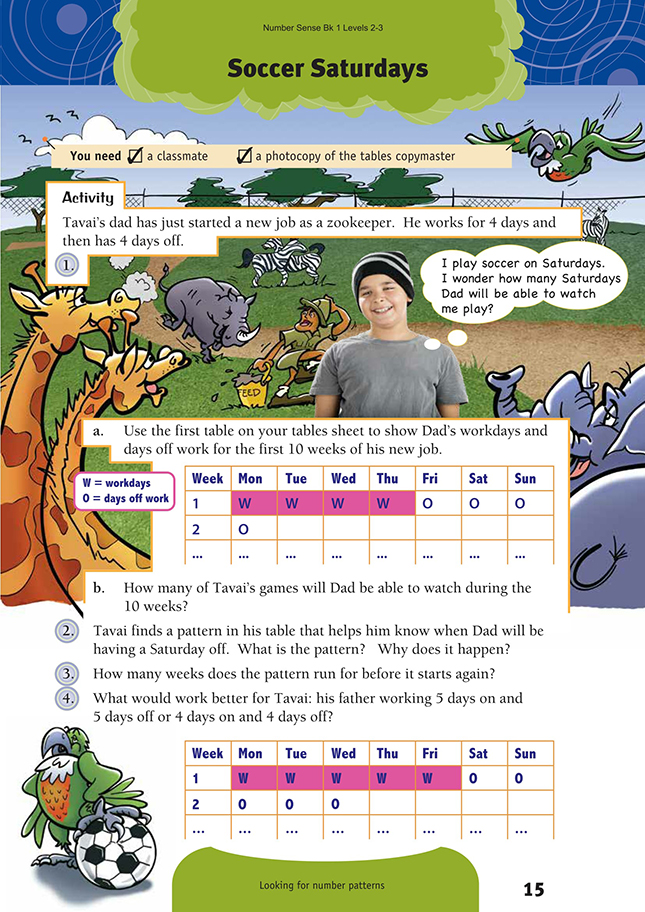This is a level 3 algebra activity from the Figure It Out series.
Click on the image to enlarge it. Click again to close. Download PDF (302 KB)
find number patterns
A classmate
FIO, Levels 2-3, Number Sense and Algebraic Thinking, Book One, Soccer Saturdays, page 15
Copymaster of the table
This activity requires students to use logic and reasoning with a number pattern to solve a valid contextual problem.
The essence of this problem is the fact that the pattern repeats in a cycle of 8 days (4 on, 4 off) whereas there are only 7 days in a week. The “extra” day means that, each time, the cycle begins 1 day later than the last time. This appears on the grid as a diagonal pattern. Don’t give the game away by explaining this to the students at the beginning because this would remove the problem solving element and reduce the activity to a series of exercises.
Introduce the activity to a guided teaching group by focusing the students on Tavai’s concern (how many Saturdays Dad can watch him play soccer) and then on Dad’s work pattern of 4 days on and 4 days off. Give the students the table copymaster and send them into problem-solving groups to attempt question 1. Then bring the groups back together to share their solutions.
Read through question 2 with the students and give them time to find and discuss any patterns. Ask the students questions such as:
Are there always 4 Ws and then 4 Os in the sequence?
What pattern do you see when you look horizontally?
Diagonally?
Vertically?
What causes the pattern to “move” as it does?
What would the pattern look like if we had an 8-day week?
(Some students may need to make an 8-day chart to answer this question.)
Subsequent discussion should make the essence of the problem clear and explicit.
The students should fill in the table for question 4 for a minimum of 12 weeks. (It begins to repeat after 10 weeks, but the students need to go a little further to confirm that this is happening.) Because the cycle is now 5 + 5 = 10, it begins each time 3 days later than it did the time before (10 = 7 + 3). Encourage your students to find and describe the patterns within the completed table.
Extension
A similar problem would be to have the students explain why their birthday is on a different day of the week each year. Explore this for ordinary years and also for a leap year. (365 = 52 x 7 + 1; 366 = 52 x 7 + 2; so the days next year are either 1 or 2 different, depending on whether the year is a leap year.)
Answers to Activity
1a.
.gif)
b. 6
2. There is a pattern of 4. From the first Saturday that he works, Tavai’s dad has 4 Saturdays on, then 4 Saturdays off, then 4 Saturdays on, and so on.
Here is one way of explaining why this happens:
Tavai’s dad has 4 days on and 4 days off, so his cycle of work and “weekends” has 8 days in it, which is 1 more than the 7 in a calendar week. This means that if he starts work this week on Tuesday, next week he will start on Wednesday
(1 day later). Also, if he starts on Tuesday this week, he will have the next 4 Tuesdays off; if he starts work this Saturday, he will be able to watch Tavai for the next 4 Saturdays in a row.
3. 8 weeks
4. Neither works better because, over the course of the year, Tavai’s dad gets half his Saturdays off in both cases. Tavai may prefer the 5 on 5 off arrangement because at most, there would be only 2 Saturdays in a row that his father couldn’t
watch him.
A 5-day pattern would look like this:
.gif)
